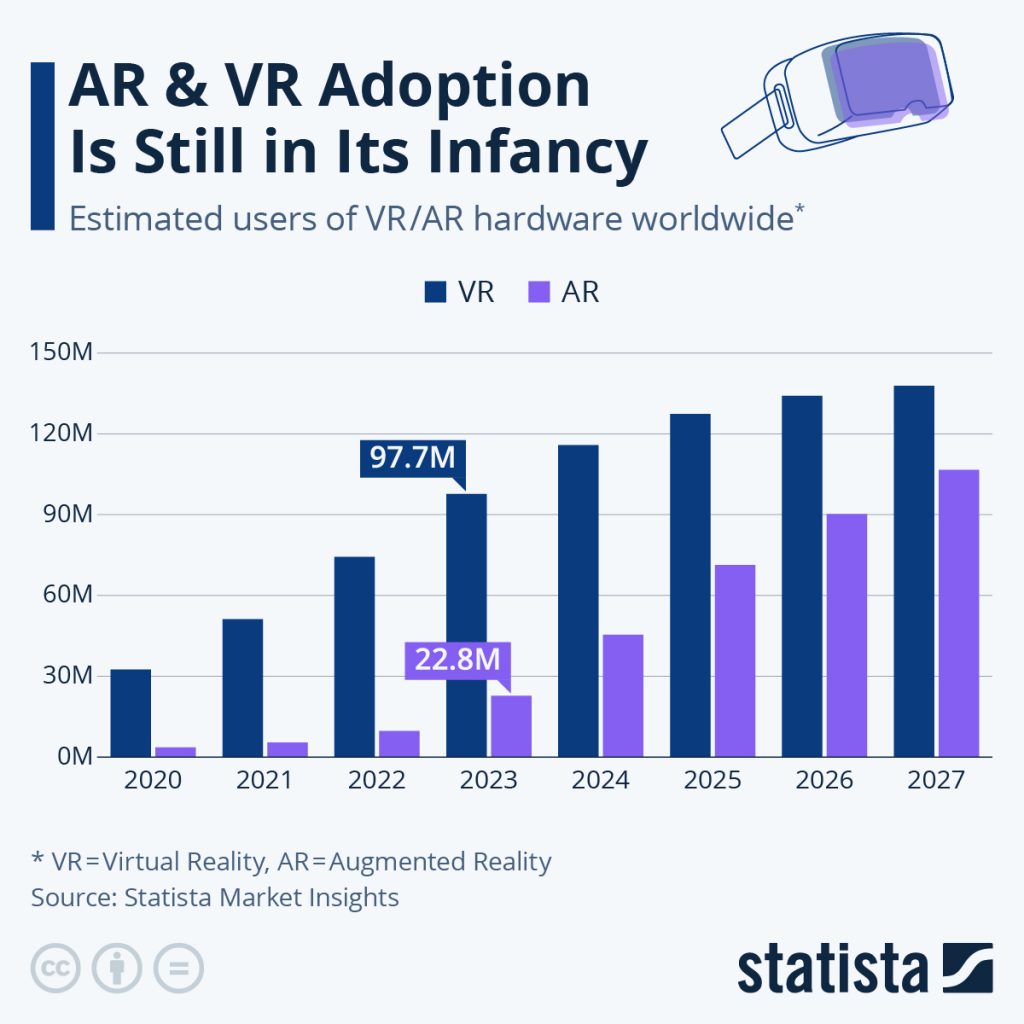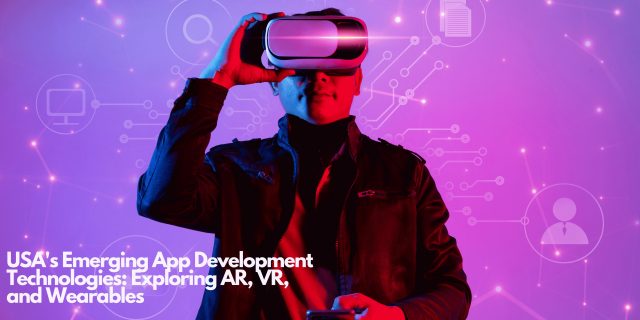The United States is a global leader in app development, and the country is also at the forefront of the development of emerging technologies such as augmented reality (AR), virtual reality (VR), and wearables. These technologies have the potential to revolutionize the way we interact with the world around us, and they are already being used in a variety of industries, including gaming, healthcare, education, and manufacturing.
The State of the AR,VR and Wearable Market in US

Source:Statista
- The global market for wearable devices and AR/VR is expected to reach 512.97 billion US dollars by 2027, growing at a compound annual growth rate (CAGR) of 16.06%.The combined market for wearables and AR/VR is expected to be a major driver of innovation in the years to come.
- The healthcare industry is the largest vertical for AR and VR, followed by retail, manufacturing, and education.
- The US is the largest market for wearables, accounting for 28% of the global market.
- The most popular wearable devices are smartwatches, fitness trackers, and smart glasses.
Top Frameworks driving the App development for AR,VR and Wearables
AR.js:
AR.js is a lightweight and easy-to-use JavaScript library that makes it easy to add augmented reality to web pages. It is supported by a wide range of devices, including smartphones, tablets, and headsets. AR.js is a good choice for projects that require simple augmented reality experiences.
A-Frame:
A-Frame is a framework for building immersive web experiences. It is based on HTML and CSS, and it makes it easy to add 3D objects, animations, and interactions to web pages. A-Frame is a good choice for projects that require more complex augmented reality experiences.
Vuforia Engine:
Vuforia Engine is a development platform that allows developers to create AR experiences for mobile devices. It supports a wide range of features, including object tracking, image recognition, and natural language understanding. Vuforia Engine is a good choice for projects that require high-performance augmented reality experiences.
Wikitude:
Wikitude is another development platform for creating AR experiences for mobile devices. It supports a wide range of features, including object tracking, image recognition, and geolocation. Wikitude is a good choice for projects that require location-based augmented reality experiences.
Babylon.js:
Babylon.js is a JavaScript 3D library that can be used to create AR and VR experiences. It is powerful and versatile, and it supports a wide range of features, including physics, lighting, and animation. Babylon.js is a good choice for projects that require high-quality AR and VR experiences.
Three.js:
While not exclusively a VR framework, Three.js is a powerful 3D graphics library that is often used in combination with other VR frameworks. It provides a foundation for building VR environments with rich graphics and interactions, making it a valuable tool for developers seeking more control and customization in their VR applications.Wearable.js:
This framework is designed specifically for building web apps for wearable devices, such as smartwatches and fitness trackers. It streamlines the development process for creating apps that can run on these compact yet powerful devices. Developers can create custom watch faces, fitness tracking apps, and more using Wearable.js.React Native for Wearables:
Leveraging the popularity of React Native, this framework extends its capabilities to wearable devices. Developers can use their React Native skills to create apps for wearables like smartwatches, ensuring a smooth and efficient development process.
Read Next: A Deep Dive into Progressive Web Apps: Benefits for US Businesses
How 5G is enabling innovation for app development
5G is a major enabler of innovation in the wearables and AR/VR fields. The faster speeds, lower latency, greater capacity, and more reliable connections offered by 5G are making it possible to develop new and more immersive wearables and AR/VR experiences.
Volvo:
Volvo is using 5G to develop AR/VR training applications for its employees. These applications allow employees to learn how to repair and maintain vehicles in a virtual environment. This is helping Volvo to improve the safety and efficiency of its training programs.
Samsung:
Samsung is using 5G to develop AR/VR applications for its Galaxy smartphones. These applications allow users to experience new and immersive content, such as games and movies. Samsung is also using 5G to develop AR/VR applications for its Gear VR headset.
Qualcomm:
Qualcomm is using 5G to develop AR/VR chips and software. These chips and software are designed to make AR/VR experiences more immersive and realistic. Qualcomm is also working with other companies to develop 5G-enabled AR/VR devices and applications.
Microsoft:
Microsoft is using 5G to develop its HoloLens 2 AR headset. The HoloLens 2 is a lightweight and powerful AR headset that uses 5G to stream high-quality video and audio. This allows users to experience immersive and realistic AR experiences.Niantic:
Niantic is using 5G to develop its Pokemon Go AR game. Pokemon Go is a popular AR game that uses GPS to track players’ movements and overlay virtual creatures onto the real world. Niantic is using 5G to improve the performance of Pokemon Go and make it more immersive.
These are just a few examples of how 5G is being used to drive innovation in the AR/VR and wearables fields, but as 5G networks continue to roll out, we can expect to see even more innovative applications of these technologies.
Recommended Articles: The Impact of AI and Machine Learning on web App Development in the USA
The Future of AR/VR and Wearable Technology
Apple’s Vision Pro introduces a cutting-edge spatial computing device, empowering developers to craft immersive AR/VR experiences. With a high-resolution display, potent processor, and expansive field of view, it promises to be a game-changer. As reputable companies like Apple enter the market, they have the potential to revolutionize content consumption, offering numerous benefits, including:
More realistic and immersive experiences:
The high-resolution display and powerful processor will allow developers to create more realistic and immersive AR/VR experiences.
Better interaction with the real world:
The wide field of view and advanced sensors will allow users to interact more naturally with the real world in AR/VR experiences. So this could lead to new applications in navigation, shopping, and healthcare.More portable and affordable devices:
This could lead to the development of more portable and affordable AR/VR devices in the future and this could make AR/VR more accessible to a wider range of people.
This is a significant advancement in the field of spatial computing.It has the potential to help developers because it creates new and innovative AR/VR experiences that could change the way we interact with the world around us.
Takeaways
In the fast-paced world of technology, where innovation is the driving force, the convergence of Augmented Reality (AR), Virtual Reality (VR), and Wearable devices is forging a path to a future that was once confined to our wildest imaginations. The frameworks discussed here are the tools that empower developers to bring this future to life, shaping the way we interact with digital content and opening doors to endless possibilities.
As we wrap up this exploration of these groundbreaking technologies and their associated frameworks, it’s worth mentioning GeekyAnts, a prominent player in the realm of web and app development. GeekyAnts is a leading tech company that specializes in creating cutting-edge solutions for web, mobile, and emerging technologies.
Contact them today!


















